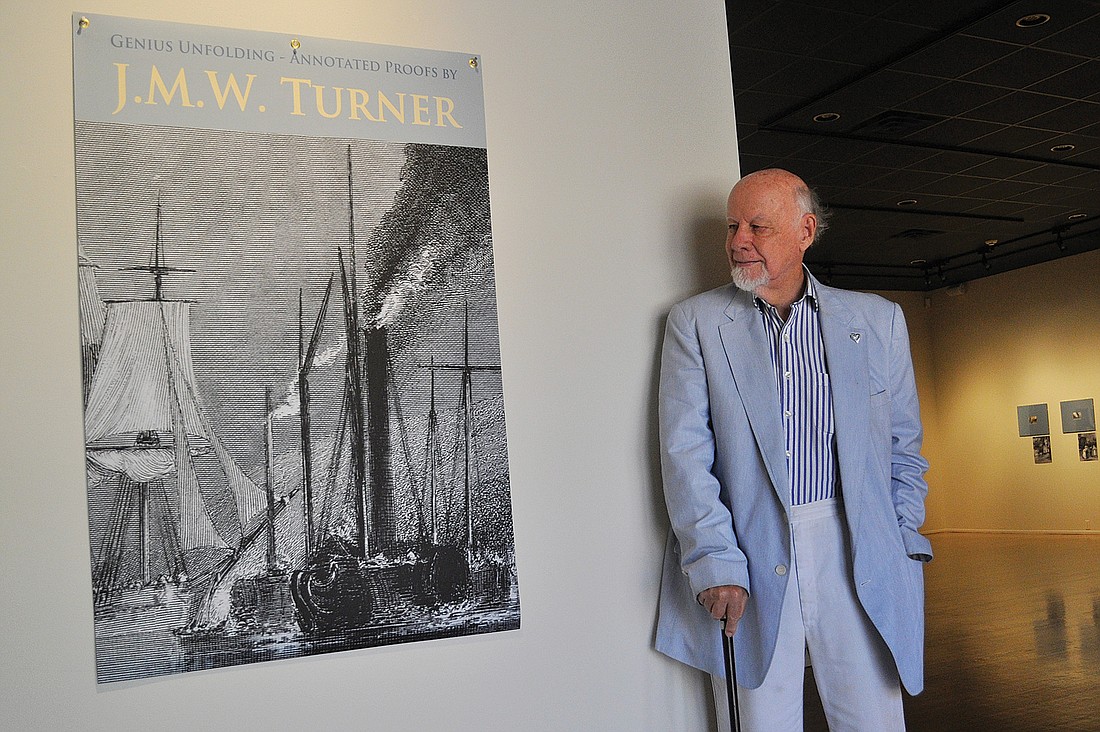- April 25, 2024
-
-
Loading

Loading

Right now, the walls of the Selby Gallery are home to dozens of lively black-and-white landscapes of 19th-century England.
“Genius Unfolding: Annotated Proofs by J.M.W. Turner” opened almost a month ago on the Ringling College of Art and Design campus.
In less than a week, the collection will come down.
It’ll get packed into crates and loaded into a storage facility in Sarasota, where it’ll sit until its owner — an 87-year-old Scottish-born art collector named Douglass Montrose-Graem — builds a downtown museum big enough to permanently exhibit it and the hundreds of other Turner works he’s collected over the years.
It sounds like an ambitious undertaking, but plans are already under way to make it happen.
For more than a year, the Sarasota art collector has been meeting to discuss the project with Chris Gallagher, a senior designer with Jonathan Parks Architect.
“It’ll be an extraordinary opportunity to have a Turner museum in Sarasota,” Montrose-Graem says. “Beyond the fact that you’ll see Turner’s work, it’ll create a great sense of synergy among other arts organizations in town.”
Montrose-Graem doesn’t just want a little space to hang his prints. He wants a campus: 70,000-square-feet centered on a city block, a mixed-use development with the museum as its focal point, modeled after the great city squares in Europe.
He wants 10 galleries, each themed for Turner’s distinctive subject matter; a theater; a restaurant; a museum store; and opportunities to share the space with local performing arts organizations.
Says Montrose-Graem: “Turner was an innovator and so am I.”
A Turner fan since the late 1960s, Montrose-Graem’s collection rounds out at 1,500 works, most of which are prints, save for one oil sketch and an early watercolor painting.
So that you fully grasp the weight of his collection, you should know that the British artist’s “Modern Rome — Campo Vaccino,” an oil painting on canvas, sold for a record $45 million two years ago to the J. Paul Getty Museum in Los Angeles.
A Sarasota resident since 1998, Montrose-Graem is no stranger to running an art museum or, for that matter, a museum devoted to Turner. In 1973, he left his job as a Wall Street analyst to open his Turner Museum inside an old Victorian mansion in Denver.
“My friends said I was crazy to go to Denver,” Montrose-Graem says. “They said, ‘No one will have an interest in Turner. You’re going to go belly-up.’ At the time, the greatest cultural destination was Buffalo Bill’s grave.”
His Wall Street buddies were wrong. The museum was open for 22 years. It closed in 1999, and since then Montrose-Graem has dreamed of re-opening it in Sarasota.
“It was a calculated risk, but a very good one,” he says. “People traveled from all over the place to come to our museum.”
So, how exactly did a finance whiz develop a passion for collecting landscapes of 19th-century Europe?
Montrose-Graem says it all stems from a show he saw in 1966 at The Museum of Modern Art: “Turner: Imagination and Reality.”
“I’m a poet at the core, so I have a lively imagination,” he says. “But I’m also a Scot, which means I’m practical. Turner spoke to both of these sides.”
Turner, whose work is often described as a precursor to impressionism, had an almost journalistic approach to capturing the vibrancy of his surroundings.
This, says Montrose-Graem, is what appealed to him most.
Much like the prints by Peter Paul Rubens that are currently on display at the John and Mable Ringling Museum of Art, Turner’s black-and-white proofs were produced by printmakers working under the artist’s tutelage.
The engravings are so tiny and tightly detailed that patrons are given magnifying glasses to view the work. Montrose-Graem’s favorite print is especially busy. Titled “Boulevard,” it illustrates a bustling street scene in Paris.
“I happen to like the French playboy sitting in front of a café,” the collector says, pointing to a miniscule drawing of a man sitting with his legs crossed and his gaze fixed on a pair of women. “He’s just sitting there watching the girls go by. Who hasn’t done that before?”
IF YOU GO
“Genius Unfolding: Annotated Proofs by J.M.W. Turner” is up now through March 28, at Selby Gallery at Ringling College of Art and Design. For more information, call 359-7563 or visit ringling.edu.